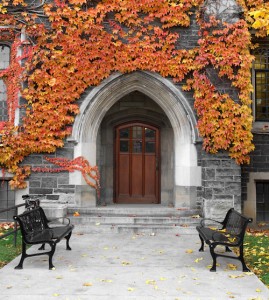“Backdoor” Admission: Earning entry to an elite college with less than elite credentials
 This article – written by teacher, administrator and adjunct professor at Temple University, Dave Bergman, Ed.D. – was reprinted with permission from College Transitions.
This article – written by teacher, administrator and adjunct professor at Temple University, Dave Bergman, Ed.D. – was reprinted with permission from College Transitions.
Two caveats, before we dish out the advice. First, as readers of our blog know, we do not advocate over-focusing on highly selective schools. Yet we also recognize that the allure of brand name universities is quite powerful and that, in some instances, those schools may represent a good “fit” for certain students.
Second warning… there is no magic button to press or secret handshake to master, which results in an acceptance letter to a colleges that might be a bit out of your league (although if there was such a handshake it would look like this). There are, however, strategies that can increase your odds.
1) The Transfer Plan
Consider starting off at a less-selective school, racking up a couple of semesters on the Dean’s List and thentransferring into the college of your dreams. Many elite schools have lower admission standards for transfer students than for high school applicants, although acceptance rates typically vary greatly from year to year based on enrollment needs.
If your prospects of getting into, say, Notre Dame out of high school are anything like this, your best bet may be working toward a transfer to South Bend after freshman year. Notre Dame, along with selective schools like The University of Virginia, Lehigh, and Tufts University are all known to be particularly transfer-friendly. For a complete list of transfer-friendly colleges, check out our Build Your College Knowledge page.
2) The Less Popular Major Maneuver
Colleges have “institutional needs” to consider during the admissions cycle. This can work to your advantage as the following example demonstrates:
Applicants to Prestige College’s Italian program have dwindled in recent years. Applicant X took four years of Italian culminating with a high score on the AP Italian Language and Culture exam. Unfortunately, Applicant X’s SATs are in the lower quartile for accepted students at Prestige College and their overall GPA, thanks to a slow start freshman year of high school, isn’t quite up to snuff either. Now, Applicant X wants to study business at Prestige College but knows he will likely be rejected from that program so he sells his background in Italian to get accepted. If the plan works, Applicant X will transfer into the business program as soon he can.
Of course, the only reason such a plan would have a prayer for success is the demonstrated interest and proficiency in Italian previously shown by Applicant X. If his only stated experience with Italian was enjoying Paul Newman’s Sockarooni pasta sauce, the college would have easily sniffed out the scheme (which, coincidentally would have smelled like diced bell peppers and garlic).
A slightly different scenario involves institutions where certain programs on campus are more selective than others. For example, countless would-be broadcast/journalism majors line up each year for a spot in Syracuse’s S.I. Newhouse School of Public Communications which has significantly more rigorous entry requirements than the rest of the University. Many students rejected from Newhouse, choose to enter Syracuse in the College of Arts and Sciences, earn top grades, and reapply after freshman year.
Of course, this major-specific strategy could backfire if you don’t earn the college grades necessary to subsequently transfer into your originally desired program.
3) Future Engineer? Consider a 3:2 Program
If you’re an aspiring engineer but lack the credentials for MIT or CalTech, a 3-2 engineering program is an avenue worth exploring. This format allows students to earn a bachelor’s degree at any one of a host of participating colleges in 3 years and then apply to a more prestigious engineering school. For instance, Columbia University’s prestigious engineering school partners with almost 100 liberal arts colleges across the country, from Ivy caliber schools like Middlebury to Marietta College in Ohio, which has a 70% acceptance rate. Students apply to Columbia during their junior year, and if accepted, spend the next two years earning a BS in engineering.




















